Blind signature scheme based on discrete logarithm problem
INTRODUCTION
The blind signature scheme was introduced by D. Chaum in 1983 [1], the scheme was used
to authorize the message integrity and also the name of signer, but the scheme does not
aothorize real original of the signed message. In other words the scheme allows to hide the
name of a original message’s author. Blind signatures scheme is one of the examples of
cryptographic schemes that have been employed extensively in privacy oriented e-servicesЭлектромагнитные волны и электронные системы №5 за 2015 г.
77
such as untraceable electronic cash, online election systems while keeping secret of voters [2-
4,5]. One point to note here is normal digital signature, the signer is also the owner of a
message but blind signature scheme the signer and the owner of a message are different. This
is the critical characteristic of the blind signature scheme and It is one important criterion for
assessing the safety of the scheme.
The paper focuses on analyzing weaknesses which can be attacked reveals the origin of a
message being signed by known blind digital scheme, which proposed a new scheme have
higher degree of security in a sense of keeping secret the source of the signed message. It will
meet the demand of the real.
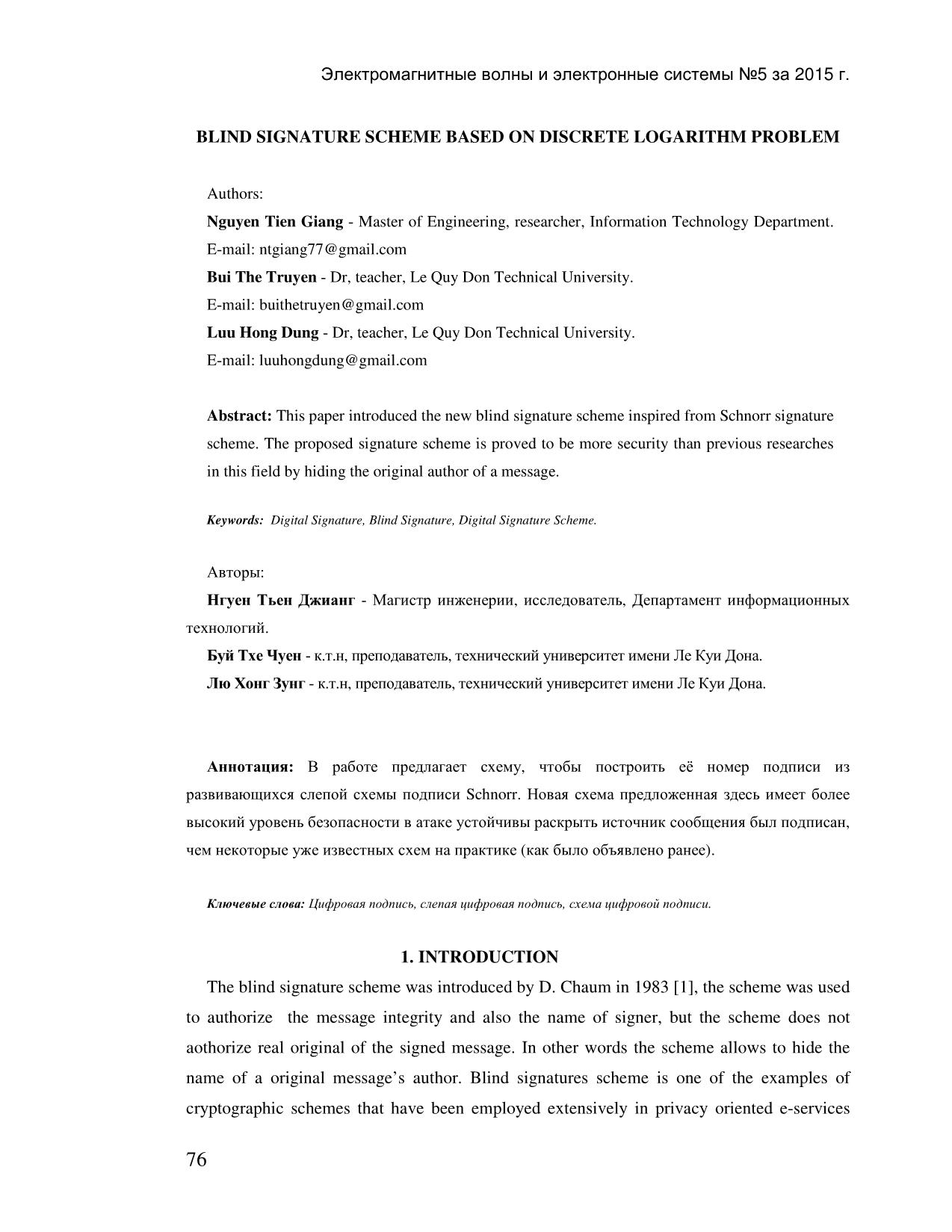
Trang 1
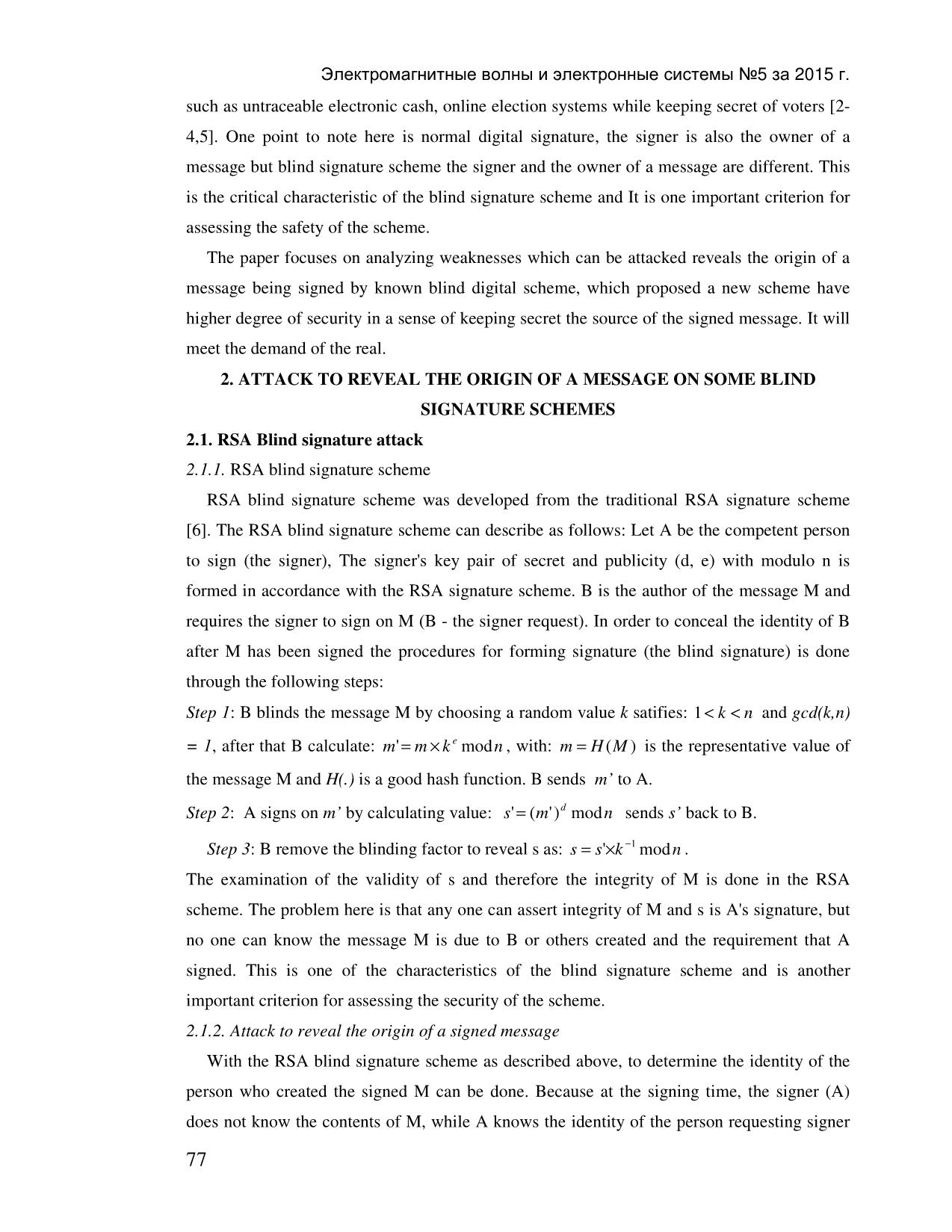
Trang 2
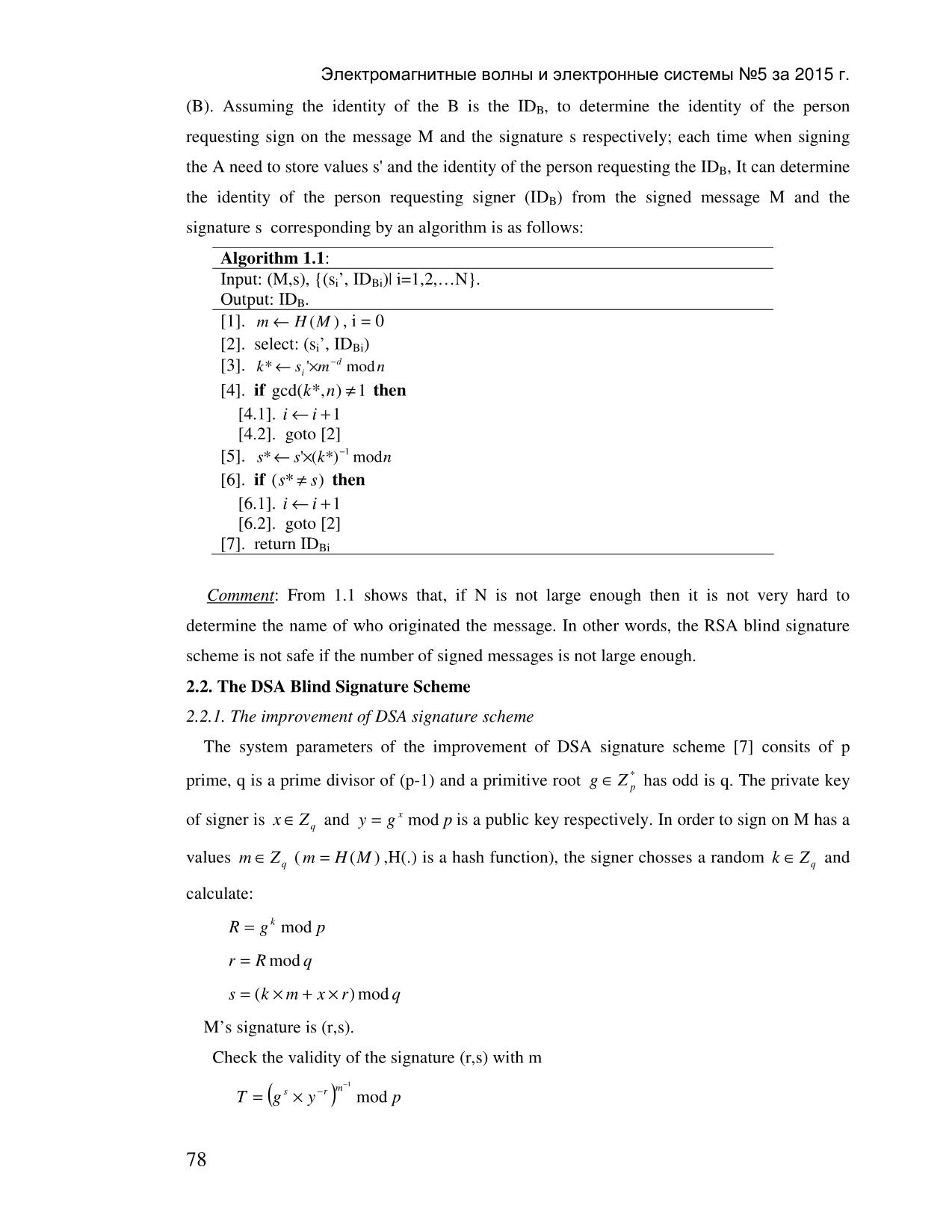
Trang 3
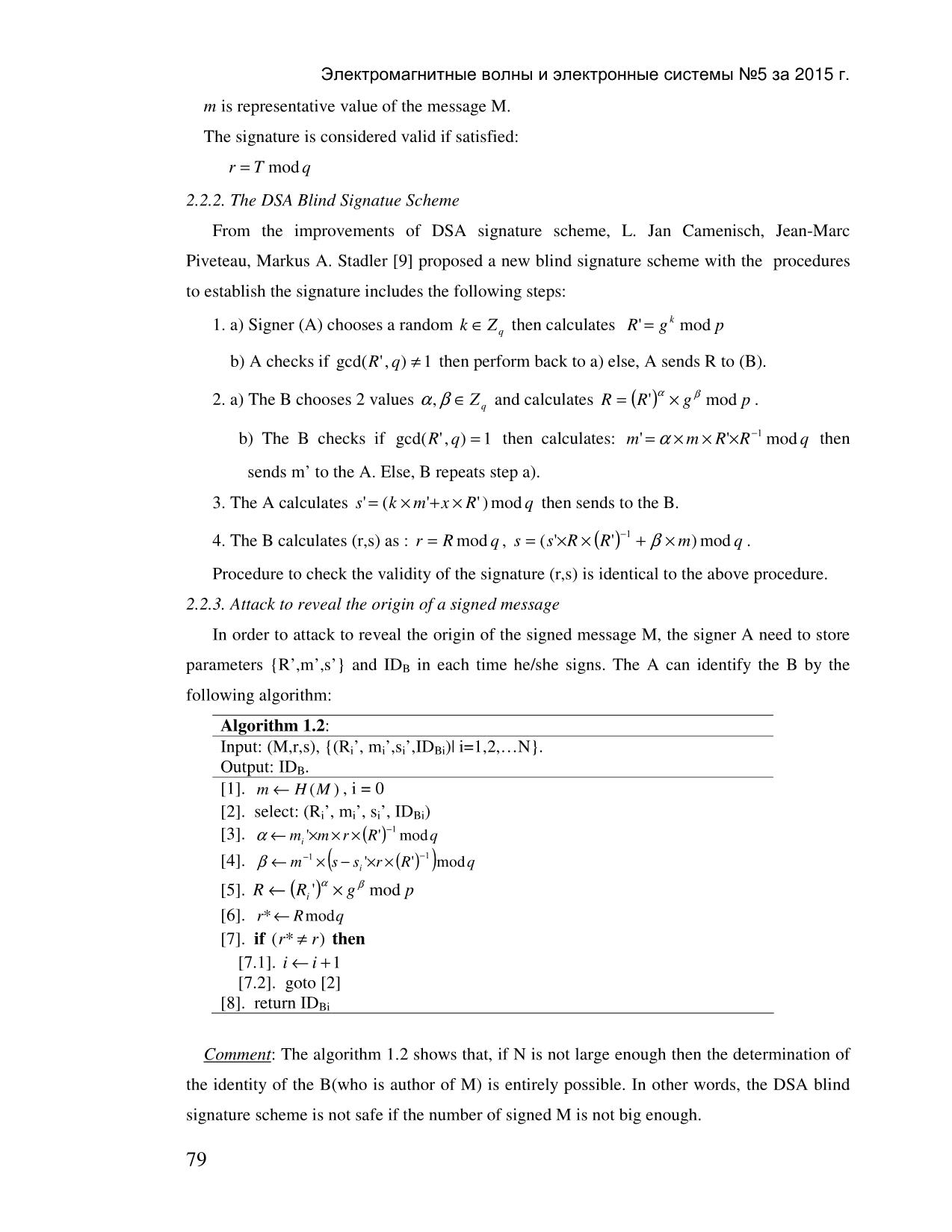
Trang 4
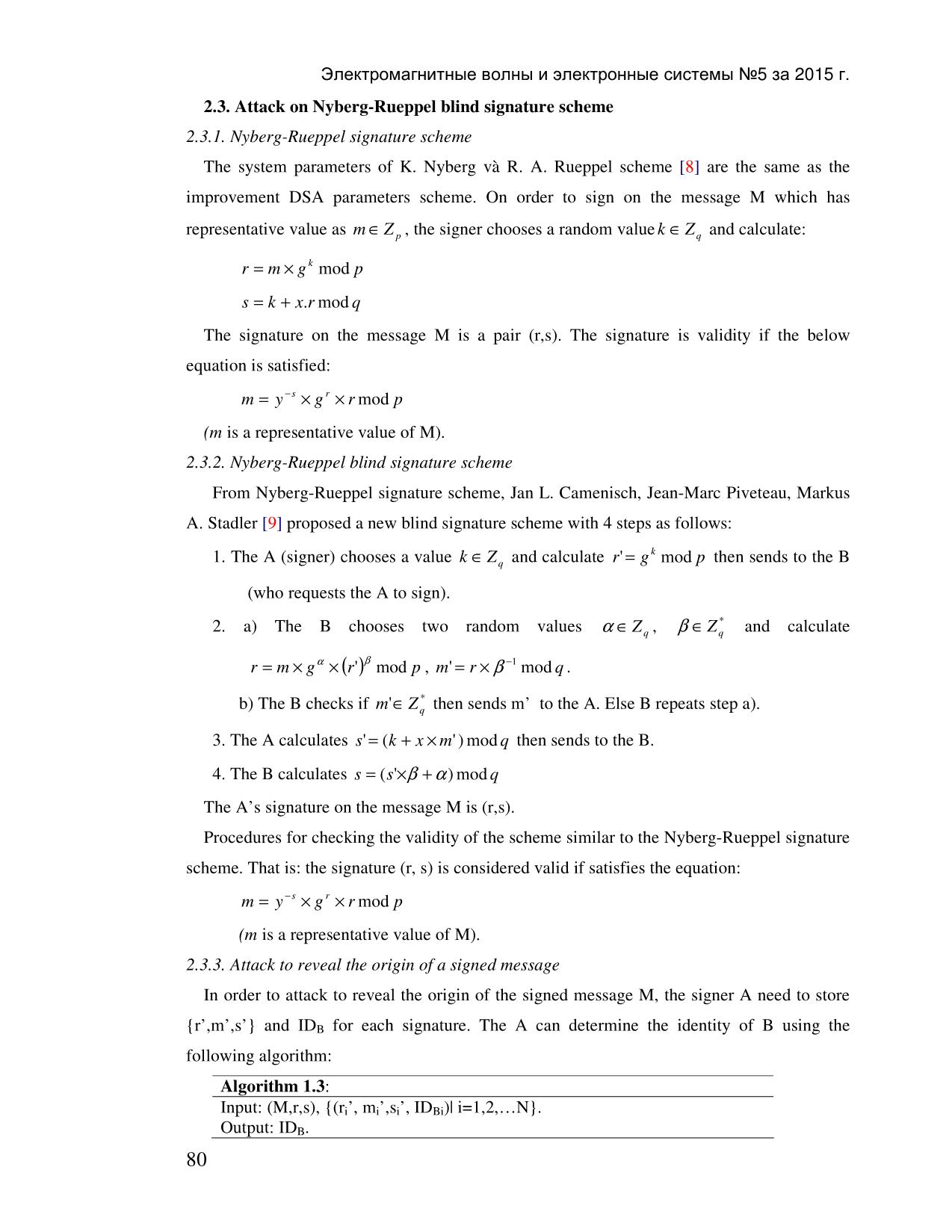
Trang 5
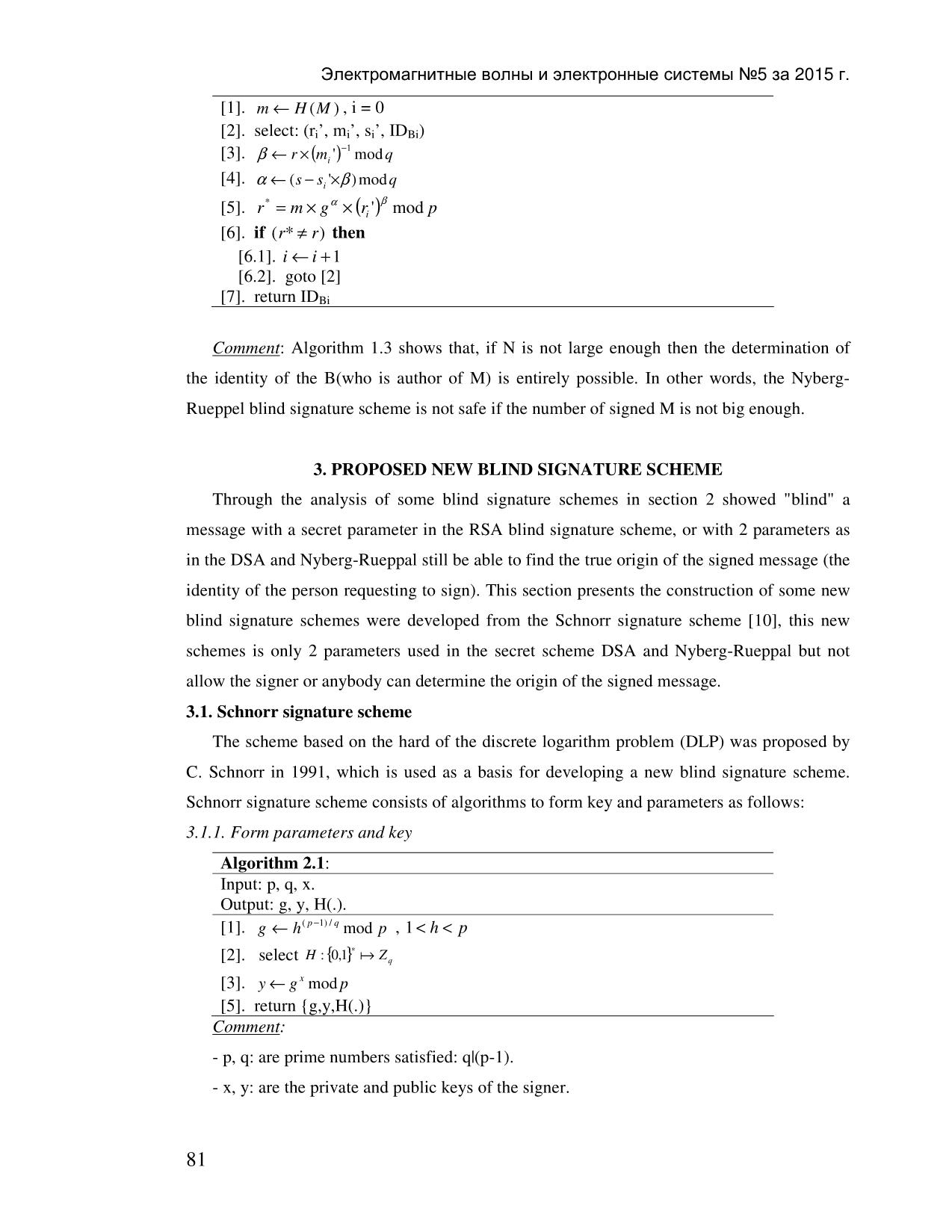
Trang 6
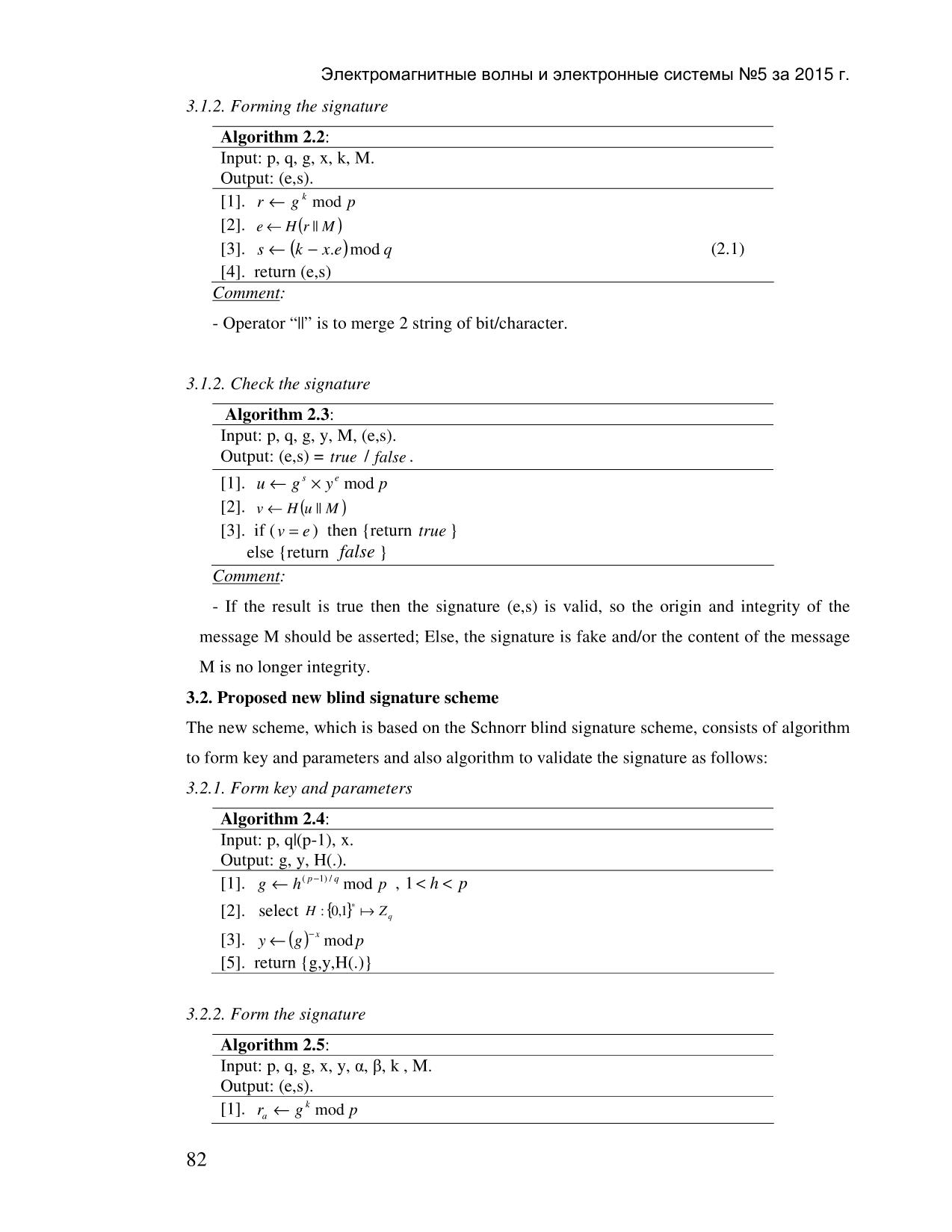
Trang 7
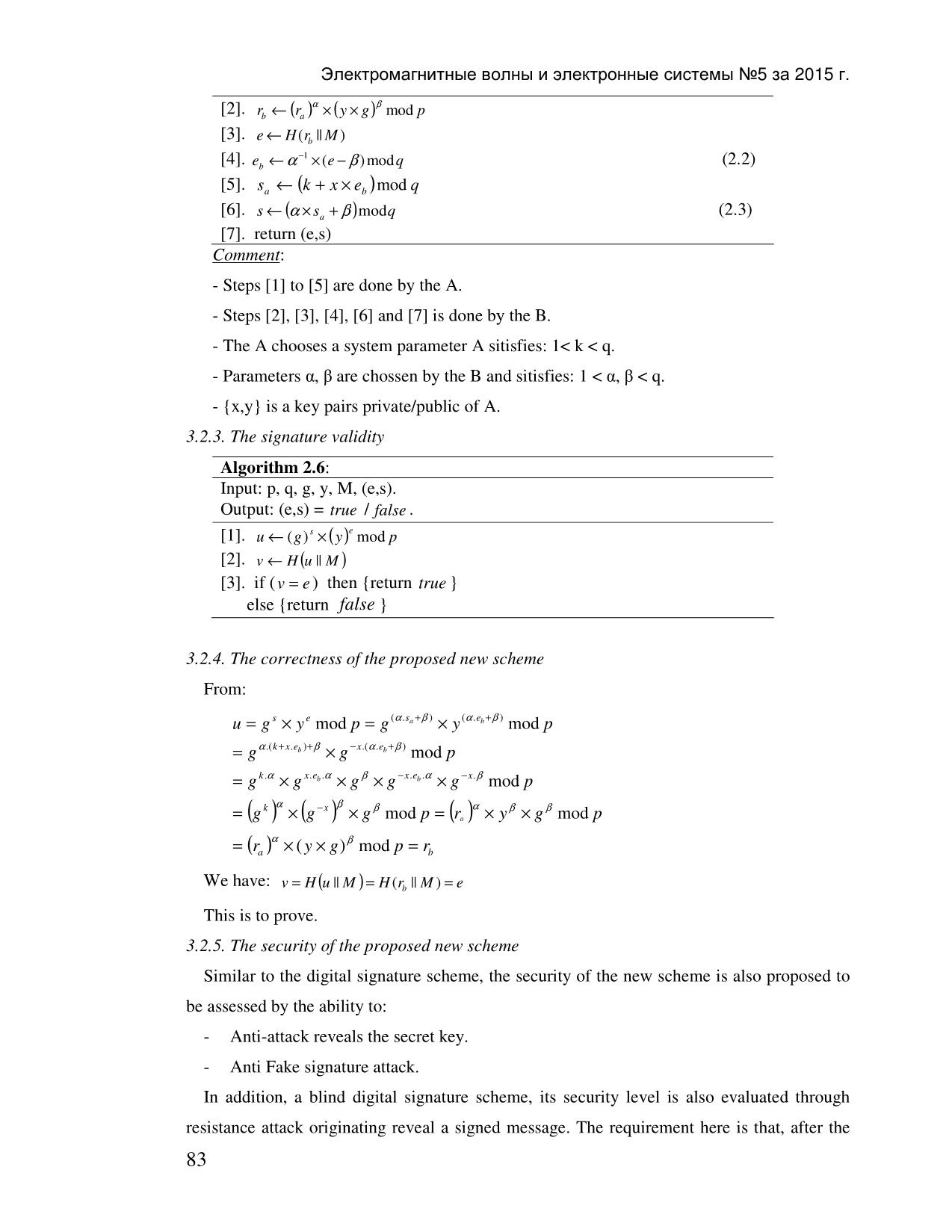
Trang 8
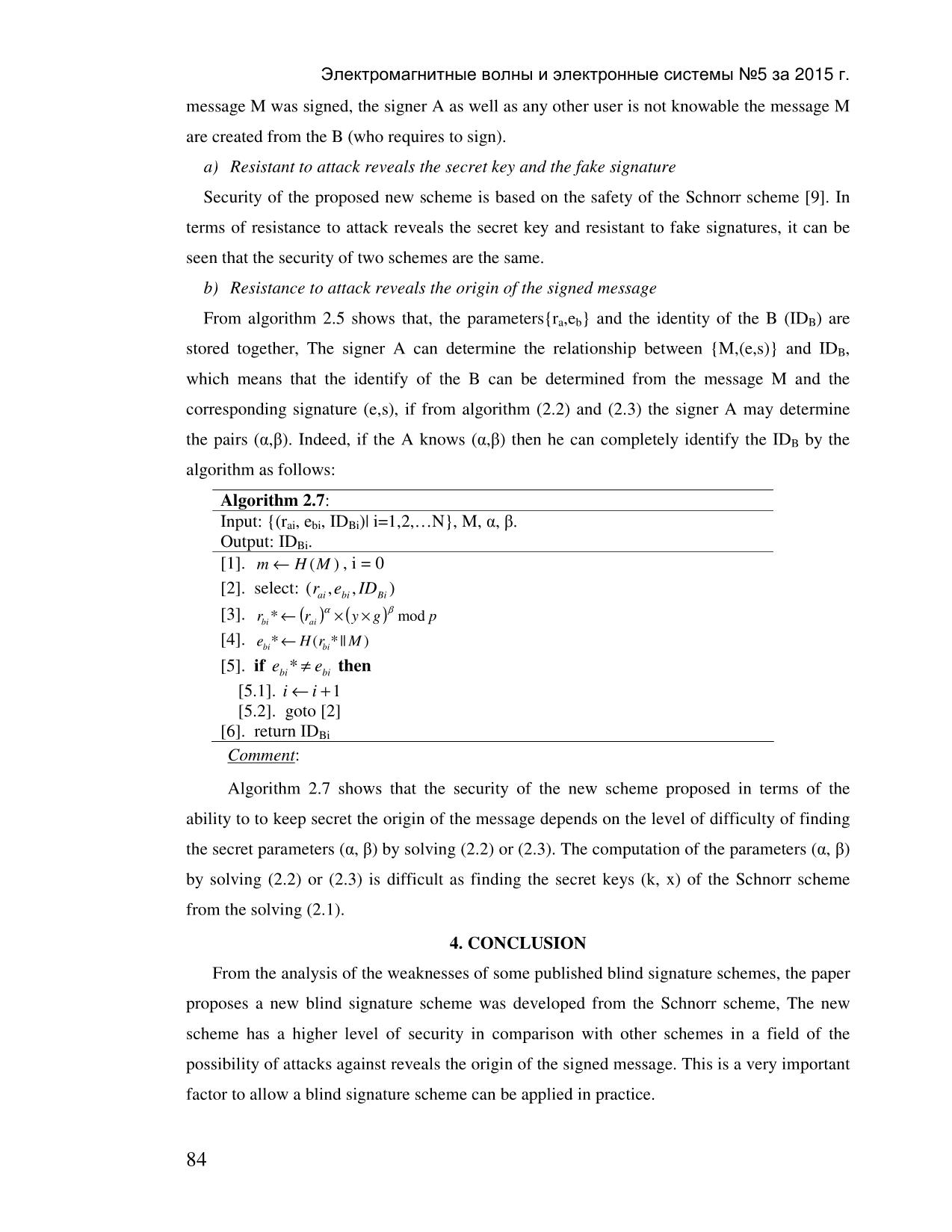
Trang 9
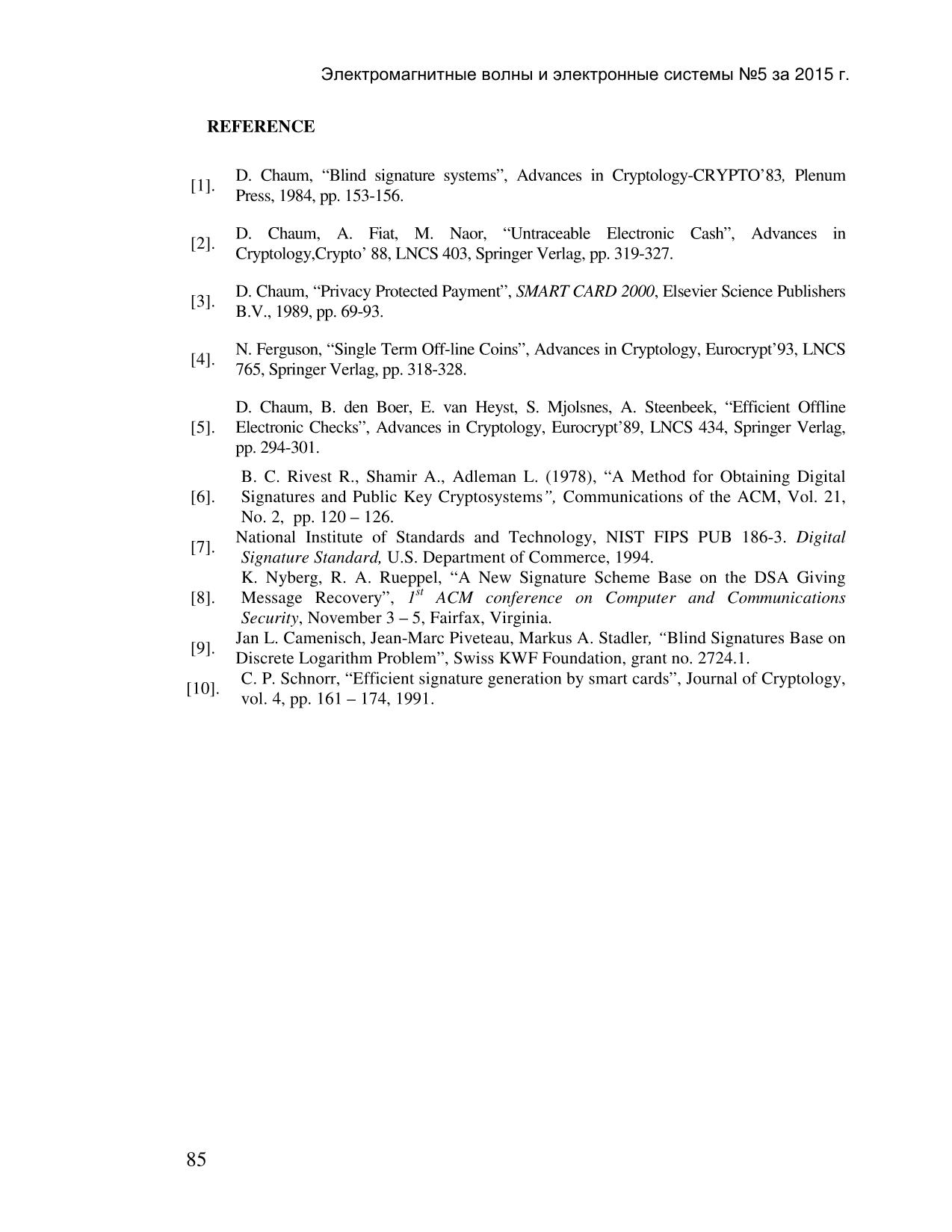
Trang 10
Tóm tắt nội dung tài liệu: Blind signature scheme based on discrete logarithm problem
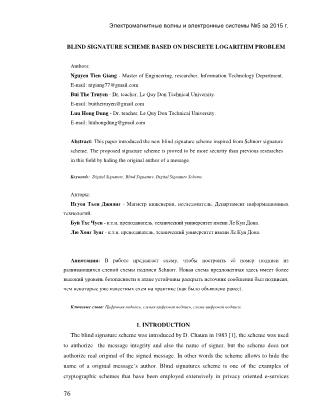
me and is another
important criterion for assessing the security of the scheme.
2.1.2. Attack to reveal the origin of a signed message
With the RSA blind signature scheme as described above, to determine the identity of the
person who created the signed M can be done. Because at the signing time, the signer (A)
does not know the contents of M, while A knows the identity of the person requesting signer
77
Электромагнитные волны и электронные системы №5 за 2015 г.
(B). Assuming the identity of the B is the ID B, to determine the identity of the person
requesting sign on the message M and the signature s respectively; each time when signing
the A need to store values s' and the identity of the person requesting the ID B, It can determine
the identity of the person requesting signer (ID B) from the signed message M and the
signature s corresponding by an algorithm is as follows:
Algorithm 1.1 :
Input: (M,s), {(s i’, ID Bi )| i=1,2,N}.
Output: ID B.
[1]. m ← H (M ) , i = 0
[2]. select: (si’, ID Bi )
−d
[3]. k* ← si '×m mod n
[4]. if gcd( k*, n) ≠ 1 then
[4.1]. i ← i +1
[4.2]. goto [2]
[5]. s* ← s'× (k *)−1 mod n
[6]. if (*s ≠ s) then
[6.1]. i ← i +1
[6.2]. goto [2]
[7]. return ID Bi
Comment : From 1.1 shows that, if N is not large enough then it is not very hard to
determine the name of who originated the message. In other words, the RSA blind signature
scheme is not safe if the number of signed messages is not large enough.
2.2. The DSA Blind Signature Scheme
2.2.1. The improvement of DSA signature scheme
The system parameters of the improvement of DSA signature scheme [7] consits of p
*
prime, q is a prime divisor of (p-1) and a primitive root g ∈ Z p has odd is q. The private key
x
of signer is x ∈ Z q and y = g mod p is a public key respectively. In order to sign on M has a
values m ∈ Z q ( m = H (M ) ,H(.) is a hash function), the signer chosses a random k ∈ Z q and
calculate:
R = g k mod p
r = R mod q
s = (k × m + x × r) mod q
M’s signature is (r,s).
Check the validity of the signature (r,s) with m
m−1
T = (g s × y −r ) mod p
78
Электромагнитные волны и электронные системы №5 за 2015 г.
m is representative value of the message M.
The signature is considered valid if satisfied:
r = T mod q
2.2.2. The DSA Blind Signatue Scheme
From the improvements of DSA signature scheme, L. Jan Camenisch, Jean-Marc
Piveteau, Markus A. Stadler [9] proposed a new blind signature scheme with the procedures
to establish the signature includes the following steps:
k
1. a) Signer (A) chooses a random k ∈ Z q then calculates R' = g mod p
b) A checks if gcd( R',)q ≠ 1 then perform back to a) else, A sends R to (B).
α β
2. a) The B chooses 2 values α, β ∈ Z q and calculates R = (R') × g mod p .
b) The B checks if gcd( R',)q = 1 then calculates: m' = α × m × R'×R −1 mod q then
sends m’ to the A. Else, B repeats step a).
3. The A calculates s'(= k × m'+x × R )' mod q then sends to the B.
4. The B calculates (r,s) as : r = R mod q , s = s'( ×R × (R')−1 + β × m) mod q .
Procedure to check the validity of the signature (r,s) is identical to the above procedure.
2.2.3. Attack to reveal the origin of a signed message
In order to attack to reveal the origin of the signed message M, the signer A need to store
parameters {R’,m’,s’} and ID B in each time he/she signs. The A can identify the B by the
following algorithm:
Algorithm 1.2 :
Input: (M,r,s), {(Ri’, mi’,s i’,ID Bi )| i=1,2,N}.
Output: ID B.
[1]. m ← H (M ) , i = 0
[2]. select: (Ri’, mi’, si’, ID Bi )
−1
[3]. α ← mi '×m × r ×(R') mod q
−1 −1
[4]. β ← m × (s − si '×r × (R') )mod q
α β
[5]. R ← (Ri ') × g mod p
[6]. r* ← Rmod q
[7]. if (*r ≠ r ) then
[7.1]. i ← i +1
[7.2]. goto [2]
[8]. return ID Bi
Comment : The algorithm 1.2 shows that, if N is not large enough then the determination of
the identity of the B(who is author of M) is entirely possible. In other words, the DSA blind
signature scheme is not safe if the number of signed M is not big enough.
79
Электромагнитные волны и электронные системы №5 за 2015 г.
2.3. Attack on Nyberg-Rueppel blind signature scheme
2.3.1. Nyberg-Rueppel signature scheme
The system parameters of K. Nyberg và R. A. Rueppel scheme [8] are the same as the
improvement DSA parameters scheme. On order to sign on the message M which has
representative value as m ∈ Z p , the signer chooses a random value k ∈ Z q and calculate:
r = m × g k mod p
s = k + x. r mod q
The signature on the message M is a pair (r,s). The signature is validity if the below
equation is satisfied:
m = y −s × g r × r mod p
(m is a representative value of M).
2.3.2. Nyberg-Rueppel blind signature scheme
From Nyberg-Rueppel signature scheme, Jan L. Camenisch, Jean-Marc Piveteau, Markus
A. Stadler [9] proposed a new blind signature scheme with 4 steps as follows:
k
1. The A (signer) chooses a value k ∈ Z q and calculate r' = g mod p then sends to the B
(who requests the A to sign).
*
2. a) The B chooses two random values α ∈ Z q , β ∈ Z q and calculate
r = m × g α × (r')β mod p , m' = r × β −1 mod q .
*
b) The B checks if m'∈ Z q then sends m’ to the A. Else B repeats step a).
3. The A calculates s'(= k + x × m )' mod q then sends to the B.
4. The B calculates s = s'( ×β + α) mod q
The A’s signature on the message M is (r,s).
Procedures for checking the validity of the scheme similar to the Nyberg-Rueppel signature
scheme. That is: the signature (r, s) is considered valid if satisfies the equation:
m = y −s × g r × r mod p
(m is a representative value of M).
2.3.3. Attack to reveal the origin of a signed message
In order to attack to reveal the origin of the signed message M, the signer A need to store
{r’,m’,s’} and ID B for each signature. The A can determine the identity of B using the
following algorithm:
Algorithm 1.3 :
Input: (M,r,s), {(ri’, mi’,s i’, ID Bi )| i=1,2,N}.
Output: ID B.
80
Электромагнитные волны и электронные системы №5 за 2015 г.
[1]. m ← H (M ) , i = 0
[2]. select: (ri’, mi’, si’, ID Bi )
−1
[3]. β ← r × (mi ') mod q
[4]. α ← (s − si '×β )mod q
* α β
[5]. r = m × g × (ri ') mod p
[6]. if (*r ≠ r) then
[6.1]. i ← i +1
[6.2]. goto [2]
[7]. return ID Bi
Comment : Algorithm 1.3 shows that, if N is not large enough then the determination of
the identity of the B(who is author of M) is entirely possible. In other words, the Nyberg-
Rueppel blind signature scheme is not safe if the number of signed M is not big enough.
3. PROPOSED NEW BLIND SIGNATURE SCHEME
Through the analysis of some blind signature schemes in section 2 showed "blind" a
message with a secret parameter in the RSA blind signature scheme, or with 2 parameters as
in the DSA and Nyberg-Rueppal still be able to find the true origin of the signed message (the
identity of the person requesting to sign). This section presents the construction of some new
blind signature schemes were developed from the Schnorr signature scheme [10], this new
schemes is only 2 parameters used in the secret scheme DSA and Nyberg-Rueppal but not
allow the signer or anybody can determine the origin of the signed message.
3.1. Schnorr signature scheme
The scheme based on the hard of the discrete logarithm problem (DLP) was proposed by
C. Schnorr in 1991, which is used as a basis for developing a new blind signature scheme.
Schnorr signature scheme consists of algorithms to form key and parameters as follows:
3.1.1. Form parameters and key
Algorithm 2.1 :
Input: p, q, x.
Output: g, y, H(.).
[1]. g ← h(p − 1) / q mod p , 1 < h < p
∗ a
[2]. select H :{} 0,1 Z q
[3]. y ← g x mod p
[5]. return {g,y,H(.)}
Comment :
- p, q: are prime numbers satisfied: q|(p-1).
- x, y: are the private and public keys of the signer.
81
Электромагнитные волны и электронные системы №5 за 2015 г.
3.1.2. Forming the signature
Algorithm 2.2 :
Input: p, q, g, x, k, M.
Output: (e,s).
[1]. r ← g k mod p
[2]. e ← H( r || M )
[3]. s ← (k − x. e)mod q (2.1)
[4]. return (e,s)
Comment :
- Operator “||” is to merge 2 string of bit/character.
3.1.2. Check the signature
Algorithm 2.3:
Input: p, q, g, y, M, (e,s).
Output: (e,s) = true / false .
[1]. u ← g s × y e mod p
[2]. v ← H( u || M )
[3]. if ( v = e ) then {return true }
else {return false }
Comment :
- If the result is true then the signature (e,s) is valid, so the origin and integrity of the
message M should be asserted; Else, the signature is fake and/or the content of the message
M is no longer integrity.
3.2. Proposed new blind signature scheme
The new scheme, which is based on the Schnorr blind signature scheme, consists of algorithm
to form key and parameters and also algorithm to validate the signature as follows:
3.2.1. Form key and parameters
Algorithm 2.4 :
Input: p, q|(p-1), x.
Output: g, y, H(.).
[1]. g ← h(p − 1) / q mod p , 1< h < p
∗ a
[2]. select H :{} 0,1 Z q
[3]. y ← (g)−x mod p
[5]. return {g,y,H(.)}
3.2.2. Form the signature
Algorithm 2.5:
Input: p, q, g, x, y, α, β, k , M.
Output: (e,s).
k
[1]. ra ← g mod p
82
Электромагнитные волны и электронные системы №5 за 2015 г.
α β
[2]. rb ← (ra ) × (y × g) mod p
[3]. e ← H( rb || M )
−1
[4]. eb ← α ×(e − β )mod q (2.2)
[5]. sa ← (k + x × eb )mod q
[6]. s ← (α × sa + β )mod q (2.3)
[7]. return (e,s)
Comment :
- Steps [1] to [5] are done by the A.
- Steps [2], [3], [4], [6] and [7] is done by the B.
- The A chooses a system parameter A sitisfies: 1< k < q.
- Parameters α, β are chossen by the B and sitisfies: 1 < α, β < q.
- {x,y} is a key pairs private/public of A.
3.2.3. The signature validity
Algorithm 2.6:
Input: p, q, g, y, M, (e,s).
Output: (e,s) = true / false .
[1]. u ← ()g s × (y)e mod p
[2]. v ← H( u || M )
[3]. if ( v = e ) then {return true }
else {return false }
3.2.4. The correctness of the proposed new scheme
From:
u = g s × y e mod p = g (.α sa +β ) × y (.α eb +β ) mod p
= g α.( k+ x.) eb +β × g −x.(α .eb +β ) mod p
= g k.α × g x.. eb α × g β × g −x.. eb α × g −x.β mod p
k α −x β β α β β
= ()()g × g × g mod p = ()ra × y × g mod p
α β
= ()ra × ( y × g) mod p = rb
We have: v = H( u || M ) = H( rb || M ) = e
This is to prove.
3.2.5. The security of the proposed new scheme
Similar to the digital signature scheme, the security of the new scheme is also proposed to
be assessed by the ability to:
- Anti-attack reveals the secret key.
- Anti Fake signature attack.
In addition, a blind digital signature scheme, its security level is also evaluated through
resistance attack originating reveal a signed message. The requirement here is that, after the
83
Электромагнитные волны и электронные системы №5 за 2015 г.
message M was signed, the signer A as well as any other user is not knowable the message M
are created from the B (who requires to sign).
a) Resistant to attack reveals the secret key and the fake signature
Security of the proposed new scheme is based on the safety of the Schnorr scheme [9]. In
terms of resistance to attack reveals the secret key and resistant to fake signatures, it can be
seen that the security of two schemes are the same.
b) Resistance to attack reveals the origin of the signed message
From algorithm 2.5 shows that, the parameters{ra,e b} and the identity of the B (ID B) are
stored together, The signer A can determine the relationship between {M,(e,s)} and ID B,
which means that the identify of the B can be determined from the message M and the
corresponding signature (e,s), if from algorithm (2.2) and (2.3) the signer A may determine
the pairs ( α,β). Indeed, if the A knows ( α,β) then he can completely identify the ID B by the
algorithm as follows:
Algorithm 2.7 :
Input: {(rai , e bi , ID Bi )| i=1,2,N}, M, α, β.
Output: ID Bi .
[1]. m ← H (M ) , i = 0
[2]. select: (rai ,ebi , ID Bi )
α β
[3]. rbi * ← (rai ) × (y × g) mod p
[4]. ebi * ← H( rbi ||* M )
[5]. if ebi *≠ ebi then
[5.1]. i ← i +1
[5.2]. goto [2]
[6]. return ID Bi
Comment :
Algorithm 2.7 shows that the security of the new scheme proposed in terms of the
ability to to keep secret the origin of the message depends on the level of difficulty of finding
the secret parameters ( α, β) by solving (2.2) or (2.3). The computation of the parameters ( α, β)
by solving (2.2) or (2.3) is difficult as finding the secret keys (k, x) of the Schnorr scheme
from the solving (2.1).
4. CONCLUSION
From the analysis of the weaknesses of some published blind signature schemes, the paper
proposes a new blind signature scheme was developed from the Schnorr scheme, The new
scheme has a higher level of security in comparison with other schemes in a field of the
possibility of attacks against reveals the origin of the signed message. This is a very important
factor to allow a blind signature scheme can be applied in practice.
84
Электромагнитные волны и электронные системы №5 за 2015 г.
REFERENCE
D. Chaum, “Blind signature systems”, Advances in Cryptology-CRYPTO’83 , Plenum
[1].
Press, 1984, pp. 153-156.
D. Chaum, A. Fiat, M. Naor, “Untraceable Electronic Cash”, Advances in
[2].
Cryptology,Crypto’ 88, LNCS 403, Springer Verlag, pp. 319-327.
D. Chaum, “Privacy Protected Payment”, SMART CARD 2000 , Elsevier Science Publishers
[3].
B.V., 1989, pp. 69-93.
N. Ferguson, “Single Term Off-line Coins”, Advances in Cryptology, Eurocrypt’93, LNCS
[4].
765, Springer Verlag, pp. 318-328.
D. Chaum, B. den Boer, E. van Heyst, S. Mjolsnes, A. Steenbeek, “Efficient Offline
[5]. Electronic Checks”, Advances in Cryptology, Eurocrypt’89, LNCS 434, Springer Verlag,
pp. 294-301.
B. C. Rivest R., Shamir A., Adleman L. (1978), “A Method for Obtaining Digital
[6]. Signatures and Public Key Cryptosystems ”, Communications of the ACM, Vol. 21,
No. 2, pp. 120 – 126.
National Institute of Standards and Technology, NIST FIPS PUB 186-3. Digital
[7].
Signature Standard, U.S. Department of Commerce, 1994.
K. Nyberg, R. A. Rueppel, “A New Signature Scheme Base on the DSA Giving
[8]. Message Recovery”, 1st ACM conference on Computer and Communications
Security , November 3 – 5, Fairfax, Virginia.
Jan L. Camenisch, Jean-Marc Piveteau, Markus A. Stadler , “Blind Signatures Base on
[9].
Discrete Logarithm Problem”, Swiss KWF Foundation, grant no. 2724.1.
C. P. Schnorr, “Efficient signature generation by smart cards”, Journal of Cryptology,
[10].
vol. 4, pp. 161 – 174, 1991.
85 File đính kèm:
 blind_signature_scheme_based_on_discrete_logarithm_problem.pdf
blind_signature_scheme_based_on_discrete_logarithm_problem.pdf

